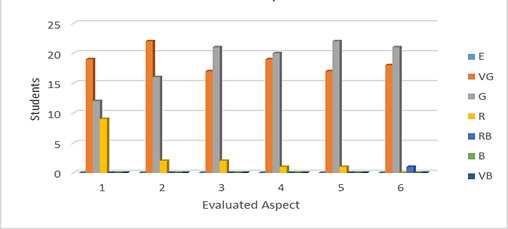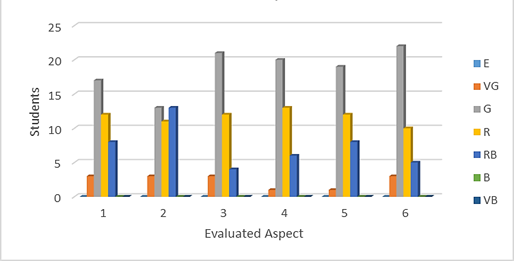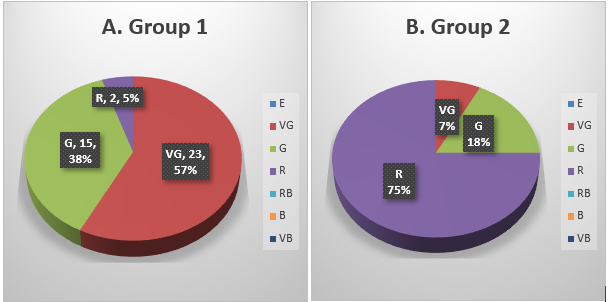Introduction
The development of problem-solving skills is one of the most important objectives of education in general, and in the teaching of Mathematics related subjects in particular. Problem solving is, therefore, widely used by science teachers both to instruct and to evaluate learning. The fact that students must be taught to solve the problems specific to each discipline should not imply that the teaching of problem solving is approached in a different or disconnected way from what happens in other disciplines. Although conceptual knowledge is specific to each domain, strategies and mental skills to solve problems do not differ significantly (Nurkhin, et al., 2020; Juandi & Tamur, 2021).
The methodology of Problem-Based Learning (PBL) constitutes the bridge that joins the theoretical principles of constructivism, instructional design and teaching practice. It is a teaching/learning strategy that has been applied for more than forty years in university teaching. It attempts to shift the concept of teaching based predominantly on the teacher as the only person responsible for transferring knowledge and the students as mere passive recipients of it, towards the identification of the student as the center and responsible for his or her own learning (Tong, et al., 2021).
PBL is an active learning process that works through the solution of problems related to the interaction of man and his environment. Its essence consists of identifying, describing, analyzing and solving such problems, which is achieved through the interaction of the teacher and the students. It can be used in the orientation of all or part of a subject, even in the development of a thematic unit; the application of this strategy is based on the design of an adequate problem in such a way that the student deepens certain topics before trying to solve them (Castaño, 2015).
According to Juandi, et al. (2021), the use of PBL has a greater positive effect than conventional instruction in terms of developing student's mathematical problem-solving skills. Moreover, mathematics teachers and professors should choose PBL as one of the best approaches in the implementation of mathematics teaching (Tong, et al., 2021).
The goals to be achieved by PBL are: that the student becomes responsible for his self-learning; diagnoses what he needs to know about a certain problem; favors scientific reasoning from the formulation of hypotheses to the systematic search for the solution of specific problems; works harmoniously with his peers through good communication and is capable of self-evaluation (Castaño, 2015; Nurkhin, et al., 2020).
Tong et al. (2021), points out that "problem-based learning represents an effective and flexible strategy that, based on what students do, can improve the quality of their university learning in very diverse aspects". Thus, the PBL helps the student to develop and work on diverse competences. Among them, the following stand out (Alzate, et al., 2013):
Problem solving.
Decision making.
Teamwork.
Communication skills (argumentation and presentation of information).
Development of attitudes and values: accuracy, review, tolerance.
According to Navarro & Suarez (2014), the PBL method it allows the formation of people capable of facing the continuous change of science and disciplines, allowing them to develop the necessary learning skills to adapt and be competent with the demands of today's society. With the development of this methodology, the students will be able to obtain the suitable aptitudes to carry out any type of logical work (Escobar, 2018).
PBL approaches have a extended history of effectiveness in different disciplines of high education, and has been demonstrated to be one of the best tools in formation of engineers for their professions, among the variety of existing instructive methods (Mann, et al., 2021).
Based on the above and the search for effective methodological strategies, that facilitate student learning and encourage self-learning and independent work in the engineering careers of the Faculty of Mathematical and Physical Sciences of the University of Guayaquil, the teachers opted for the application of the PBL in the area of Mathematics, specifically in a regular course of Differential Equations.
The course of Differential Equations was selected because it is a subject that requires the use of previous knowledge of the courses of Differential and Integral Calculus and Linear Algebra, and at the same time provides knowledge that will be useful in other courses of the engineering area, such as Electrical Circuits, Electricity and Magnetism, among others.
The present work has as objective to value the incidence of the methodology Problem-Based Learning (PBL) as a didactic strategy in the process of teaching and learning of the subject Differential Equations.
Materials and methods
In order to meet the objective, set, the group of the Networking and Telecommunications Engineering degree course that received the subject during the first cycle of the 2020-2021 academic year (total population of 40 students, Group 1) was evaluated, in which the PBL method was applied in the topics of Application of differential equations of first and second order, respectively. As a control group, it was also evaluated the group that received the same subject, in the same period, but of the Software Engineering career, conformed by 36 students (Group 2). In this group, the PBL methodology was not applied, but the subjects of the course were taught in the traditional way.
At the end of the cycle, each student was evaluated qualitatively by the professor, between Excellent and Very Bad, in terms of the following aspects:
Communication skills (argumentation and presentation of information).
Academic Results.
Self-management of knowledge.
Collaborative work.
Enhancing Creativity.
Development of professional skills and competences.
For a more effective management of subjectivity and indetermination in the evaluations, linguistic terms associated with sets of neutral numbers were used. Below, some basic concepts of neurosophy are presented and applied in this research.
Neutrosophy is a mathematical theory developed by Florentin Smarandache to deal with indetermination (Smarandache, 1998, cited by Stanujkic, et al., 2018). It has been the base for the development of new methods to handle indeterminate and inconsistent information as the neutrosophical sets and the neutrosophical logic and, especially, in the problems of decision making (Smarandache, 2005; Leyva & Smarandache, 2018; Liu, et al., 2018). The truth value in the neutrosophical set is the following (Gayen, et al., 2020):
Let be  , a neutral evaluation of a mapping of a group of formulas propositional to N, and for each sentence p you have:
, a neutral evaluation of a mapping of a group of formulas propositional to N, and for each sentence p you have:
In order to facilitate the practical application to decision-making problems, the use of Single-Value Neutral Sets (SVNS) (Liu & Tang, 2016; Liu & Shi, 2017) was proposed, through which it is possible to use linguistic terms, in order to obtain a greater interpretability of the results.
Let X be a universe of discourse, a SVNS A over X has the following form:
Where
The intervals  denote the memberships to true, indeterminate and false from x in A, respectively. For convenience a Single Value Neutrosophic Number (SVNS) will be expressed as A = (a, b, c), where a, b, c ∈ [0.1] and satisfies 0 ≤ a + b + c ≤ 3.
denote the memberships to true, indeterminate and false from x in A, respectively. For convenience a Single Value Neutrosophic Number (SVNS) will be expressed as A = (a, b, c), where a, b, c ∈ [0.1] and satisfies 0 ≤ a + b + c ≤ 3.
The single-value weighted neutrosophical mean (SVNWA) is defined as follows (Leyva & Smarandache, 2018; Liu & Teng, 2018):
Let  then, the Single Valued Neutrosophic Weighted Average Operator is defined by:
then, the Single Valued Neutrosophic Weighted Average Operator is defined by:
Where:
Let A = (a, b, c) be a single neutrosophic number, a score function S of a single valued neutrosophic value, based on the truth-membership degree, indeterminacy-membership degree and falsity membership degree is defined by Leyva & Smarandache, (2018):
The evaluations of each aspect for each student were determined by the associated linguistic terms SVN numbers as shown in Table 1.
Table 1 - Linguistic terms used for the evaluation.
| Linguistic term | Evaluation | SVN Numbers |
|---|---|---|
| Excellent | E | (1; 0; 0) |
| Very Good | VG | (0,8; 0,15; 0,20) |
| Good | G | (0,60; 0,35; 0,40) |
| Regular | R | (0,50; 0,50; 0,50) |
| Regular Tending To Bad | RB | (0,40; 0,65; 0,60) |
| Bad | B | (0,20; 0,85; 0,80) |
| Very Bad | VB | (0; 1; 1) |
To aggregate the evaluations of each student and of each aspect for the evaluation of the group as a whole, the single-value weighted neutral mean (SVNWA) calculated by equation (3) was used. The same weight was assumed for all aspects evaluated (wj equal to 0.1667).
Once the aggregations were obtained, the scoring function (4) was used to obtain a single evaluation value per student and per aspect evaluated. With this value, a qualitative evaluation was obtained by determining the belonging of the score value to one of the intervals shown in table 2. To calculate these intervals, 3 (the maximum score to be obtained) was divided by 7 (number of language terms used).
Table 2 - Intervals for student evaluation according to score function value.
| Scoring Intervals | Evaluation | Linguistic Term |
|---|---|---|
| [2,571 - 3] | E | Excellent |
| [2,143 - 2,571) | VG | Very Good |
| [1,714 - 2,143) | G | Good |
| [1,286 - 1,714) | R | Regular |
| [0,857 - 1,286) | RB | Regular Tending To Bad |
| [0,429 - 0,857) | B | Bad |
| [0 - 0,429) | VB | Very Bad |
Based on these results, the results of the student evaluations were analyzed by group in each aspect and in general to evaluate the incidence of the application of the PBL methodology in the process of teaching and learning of the subject.
Results and discussion
The overall results of student assessment in each aspect are shown in Figures 1 and 2. The histograms presented shown the absolute frequencies observed at the end of the evaluation process, according to the linguistic terms presented in Table 2.

Note: Group 1, in which the PBL methodology was applied
Fig. 1 - Evaluation results of students of group 1 in each aspect.

Note: Group 2, in which PBL methodology was not applied
Fig. 2 - Evaluation results of students of group 2 in each aspect.
It could be observed that in Group 1, where the PBL methodology was applied, the evaluations oscillated mostly between Good and Very Good, being greater the dispersion in the aspects of Communication skills (argumentation and presentation of information) (1) and Academic Performance (2) when reaching 19 and 22 students evaluations of Very Good and 9 and 2 evaluations of Regular, respectively. In the remaining four aspects the evaluations were between Good and Very Good, with predominance of the first, with only one student with a lower evaluation. In aspect 6 (Development of professional skills and competences) only one student was evaluated from Regular tending to Bad.
In the control group, Group 2, where the methodology was not applied, the students' evaluations were more dispersed, between Regular tending to Bad and Good, being evaluated from Very Good only between 1 and 3 students in each aspect. Although the most frequent evaluation was of Good, the evaluations of Regular and Regular tending to Bad reach important values being in some cases higher than half of the total group. In the aspect of Academic Performance (2) the worst results were observed.
By adding the evaluations per student from the SVNWA operator, to determine their corresponding score and general evaluation, the overall results of the evaluation of the students by each group can be seen in figure 3.
In the first group, of the 40 students, 23 were evaluated as Very good, 15 as Good and 2 as Regular, thus showing a predominance of students with favorable evaluation. In group 2, the majority of the students were evaluated as Regular.
Adding the students' evaluations for each aspect evaluated in both groups, the results shown in table 3 were obtained.
Table 3 - General evaluation of each group by aspect evaluated.
| Evaluated Aspect | Group 1 | Group 2 | ||||
|---|---|---|---|---|---|---|
| Aggregated SVNS | Score | Evaluation | Aggregated SVNS | Score | Evaluation | |
| 1. Communication skills (argumentation and presentation of information) | (0,7; 0,25; 0,3) | 2,141 | G | (0,54; 0,44; 0,43) | 1,662 | R |
| 2. Academic results | (0,72; 0,22; 0,28) | 2,223 | VG | (0,56; 0,41; 0,42) | 1,721 | G |
| 3. Self-management of knowledge | (0,7; 0,25; 0,3) | 2,148 | VG | (0,58; 0,39; 0,42) | 1,773 | G |
| 4. Collaborative work | (0,71; 0,24; 0,29) | 2,185 | VG | (0,55; 0,42; 0,44) | 1,691 | R |
| 5. Enhancing Creativity | (0,7; 0,25; 0,3) | 2,154 | VG | (0,54; 0,43; 0,44) | 1,672 | R |
| 6. Development of professional skills and competences | (0,7; 0,24; 0,29) | 2,166 | VG | (0,58; 0,39; 0,41) | 1,776 | G |
In all aspects evaluated, group 1 (to which the PBL methodology was applied) obtained higher evaluations than group 2. The most significant differences were found in the aspects of Communication skills, Collaborative work and Empowerment of creativity, being remarkable the incidence of this methodology in these aspects.
The study carried out allowed verifying that the students saw their results favored in each of the aspects evaluated from the application of the PBL method. Communication skills, in terms of argumentation and presentation of information, as well as Collaborative work, were positively affected thanks to the didactic advantages offered by the method through teamwork. These results coincide with those obtained by Sugiharto, et al. (2019), and were possible due to the correct methodological use of PBL.
In these aspects, the role of the teacher as a facilitator of the debate from the use of key questions and the constant invitation to the exchange of ideas inside and outside the formed teams played a determining role. And it generated a group identification on the part of the students based on the associations among peers for the achievement of common objectives.
Derived from this same process of discussion and questioning in pursuit of debate, it was possible to achieve greater creativity when facing the solution of problems, in combination with self-management of knowledge, stimulated through the oriented extra-class activities. This allowed the development of reflections with different degrees of complexity, contributing to the improvement of learning systems, through the incorporation and critical analysis of new information. Similar results were obtained by Nurdyansyah, et al. (2021), who worked in a context of greater complexity, due to the handling of scientific and religious components in Islamic elementary schools.
These aspects described lead to the acquisition of conventional skills to face diverse learning circumstances in the future professional performance of the Networking and Telecommunications Engineering student, when faced with collective decision-making scenarios for the solution of problems typical of the work environment.
As a consequence of all the above, a higher academic performance was observed in the students of the first group, since the application of the PBL method contributed significantly to the appropriation and systematization of shared knowledge. Hence, globally, the students in Group 1 achieved a higher score in each of the aspects. By averaging the scores in Table 3, an overall difference of more than 20% can be perceived, with respect to the group in which conventional teaching methods were used.
Conclusions
Through the study of the theory consulted, it was possible to confirm that the methodology of problem-based learning (PBL) is a tool that places the student at the center of the teaching-learning process and contributes to the formation of professionals capable of adapting to the current social challenges and scientific-technical development.
The neutral evaluation of the impact of the implementation of the PBL methodology for the learning of the Differential Equations content, revealed a positive impact of this strategy, according to six fundamental aspects of the formation of the professional in students of engineering careers.
The main results were evidenced by the comparative analysis aspect/student, aggregated evaluation/student and in the general comparison aspect/group. In the latter, a greater impact on the aspects should be highlighted: Communication Skills, Collaborative Work and Empowerment of Creativity.






















